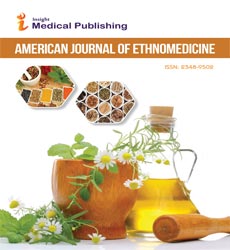ISSN : 2348-9502
American Journal of Ethnomedicine
Ethnomedicinal Plants for Wound Healing: Traditional Knowledge to Modern Applications
Yong Chen
Department of Traditional Medicine, University of Guizhou, Guiyang, Guizhou province, China
Corresponding author:
Yong Chen,
Department of Traditional Medicine, University of Guizhou, Guiyang, Guizhou province, China;
Email: yong@chen.cn
Received date: February 01, 2025, Manuscript No. Ipaje-25-20600; Editor assigned date: February 03, 2025, PreQC No. Ipaje-25-20600 (PQ); Reviewed date: February 15, 2025, QC No. Ipaje-25-20600; Revised date: February 22, 2025, Manuscript No. Ipaje-25-20600 (R); Published date: February 28, 2025, DOI: 10.36648/ 2471-7975.12.1.105
Citation: Chen Y (2025) Ethnomedicinal Plants in Wound Healing: Bridging Traditional Remedies with Modern Therapeutics. Am J Ethnomed Vol.12 No.1:105
Introduction
For centuries, ethnomedicinal plants have been central to traditional healing systems worldwide, used to treat wounds, burns, and skin infections through their natural abilities to reduce inflammation, fight microbes, and stimulate tissue repair. The shift from traditional practices to modern scientific validation highlights their therapeutic promise, as bioactive compounds from these plants are increasingly investigated for wound-healing potential. This transition provides opportunities to create safe, accessible, and effective plant-based therapies as alternatives or complements to conventional wound-care treatments [1].
Description
Traditional remedies for wound healing often relied on poultices, pastes, and extracts derived from plants such as Aloe vera, Curcuma longa (turmeric), Azadirachta indica (neem), and Centella asiatica (gotu kola), which were applied directly to injuries to alleviate pain, prevent infection, and accelerate tissue regeneration. These practices, rooted in empirical knowledge and refined through generations, formed an essential part of cultural health systems. Their therapeutic use extended beyond antimicrobial and anti-inflammatory effects, as many plants were also valued for their capacity to stimulate collagen production and angiogenesis, both critical for effective tissue repair. Modern biomedical research has provided scientific grounding for these traditional practices by isolating and characterizing the active compounds responsible for healing. For example, polysaccharides in Aloe vera enhance fibroblast proliferation Flavonoids, tannins, and terpenoids from diverse plants further contribute to reducing oxidative stress, protecting tissues, and promoting re-epithelialization. Advances in formulation science and biotechnology have expanded applications, incorporating plant extracts into hydrogels, ointments, nanofibers, and bioactive dressings that improve stability, ensure controlled release, and increase the bioavailability of active agents, thereby enhancing wound care effectiveness [2]. Despite these innovations, several challenges hinder the direct integration of ethnomedicinal plants into mainstream medicine. Variability in species, cultivation, harvesting, and extraction methods affects consistency and potency, while limited clinical trials restrict the establishment of evidence-based protocols. Concerns over safety, toxicity at higher doses, and interactions with standard drugs further complicate their acceptance. However, interdisciplinary advances in pharmacognosy, nanotechnology, and regenerative medicine are steadily addressing these barriers, paving the way for reliable plant-based wound-care solutions that combine traditional wisdom with scientific precision [3,5].
Conclusion
Ethnomedicinal plants remain powerful resources for wound healing, offering natural compounds that aid tissue repair, prevent infections, and control inflammation, validated by both traditional knowledge and emerging scientific research. While challenges in standardization and clinical validation persist, the integration of these botanicals into modern wound-management systems represents an innovative and sustainable healthcare strategy, uniting ancestral practices.
References
- Jiang J, Li D, Li F, Li H, Zhang X, et al. (2024) Catechin Promotes Endoplasmic Reticulum Stress-Mediated Gastric Cancer Cell Apoptosis Via NOX4-Induced Reactive Oxygen Species. Mol Cell Biochem 480: 3201-3215
Google Scholar Cross Ref Indexed at
- Shimoyama AT, Santin JR, Machado ID, Silva AMO, Melo ILP, et al. (2013) Antiulcerogenic Activity of Chlorogenic Acid in Different Models of Gastric Ulcer. Naunyn-Schmiedeberg’s Arch Pharmacol 386: 5-14
Google Scholar Cross Ref Indexed at
- Kolgazi M, Cilingir S, Yilmaz O, Gemici M, Yazar H, et al. (2021) Caffeic Acid Attenuates Gastric Mucosal Damage Induced by Ethanol in Rats Via Nitric Oxide Modulation. Chem Biol Interact 334: 109351
Google Scholar Cross Ref Indexed at
- Ermis A, Aritici Colak G, Acikel-Elmas M, Arbak S, Kolgazi M (2023) Ferulic Acid Treats Gastric Ulcer Via Suppressing Oxidative Stress and Inflammation. Life 13: 388
Google Scholar Cross Ref Indexed at
- Alkushi AGR, Elsawy NAM (2017) Quercetin Attenuates Indomethacin-Induced Acute Gastric Ulcer in Rats. Folia Morphol 76: 252-261
Open Access Journals
- Aquaculture & Veterinary Science
- Chemistry & Chemical Sciences
- Clinical Sciences
- Engineering
- General Science
- Genetics & Molecular Biology
- Health Care & Nursing
- Immunology & Microbiology
- Materials Science
- Mathematics & Physics
- Medical Sciences
- Neurology & Psychiatry
- Oncology & Cancer Science
- Pharmaceutical Sciences
